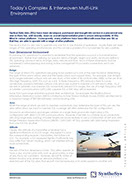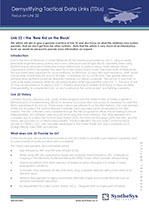info@synthesys.co.uk • +44 (0) 1947 821464
Link 22
Developed to improve on and replace the previous Link 11 system, which has its own bespoke message structure, Link 22 provides compatibility with the J-Series message family with much improved data throughput. As a NATO project, the capability is being implemented in many maritime and other platforms.
Our engineering team has specific experience in the development of the Link 22 implementation for the UK's Type 45 destroyer in particular and the ongoing development of the Link 22 message set as part of the J-Series message family in general.
Link 22 was developed under full NATO control with the specific software of the System Network Controller (SNC) being provided to user platforms for integration with their host TDL systems. Communications Security is also a specific NATO equipment provision. The principal activity for any platform is, therefore, the integration of the capability with the TDL host processor and/or the command system depending on the architecture in use.
Operations
Our ex-military operations personnel and engineering experts provide specialist knowledge across the full spectrum of Link 22 Network Enabled Capability (NEC) needs in the single service and joint warfare environments.
Our expertise includes:
- Multi-threat maritime operations.
- Airborne Early Warning (AEW) communications in multi-threat environments.
- Ground environment data exchange and interoperability.
- Development of Link 22 message standards across all military environments.
- Operational Test and Evaluation of platform capabilities.
- Link 22 Network Management.
A significant amount of capability for the management of Link 22 networks is provided by the software given to platforms. However, Link 22 networks still need to be fully integrated in multi-TDL network operations. For more information about our Network Management capability, please click here.
Message Standards
The Link 22 message capability of most, if not all, platforms is invariably implemented as part of the mission or combat systems by dedicated platform engineers in response to specific information exchange requirements. The interoperability of each Link 22 platform is critically dependent upon those platform engineers being provided with concise and accurate interface standards. Moreover, virtually all Link 22 message changes will be made coincident with the same changes being applied to Link 16.
We continue to have extensive involvement in the ongoing process of improving and correcting the interface standards and offer significant standards management capability through our SPIRIT process.
Testing Support
Link 22 testing is a through-life activity that starts by confirming the theoretical implementation, testing conformance with the standards, and conducting live trials.
We provide support to the UK MOD covering all aspects of Wide Area Network testing for a number of air and surface platforms that operate Link 16, developing test strategies at the system and platform level. As a major element of this activity, we operate and manage the UK Multi-Link Test Facility, including preparation of test scripts and analysis of results. We anticipate that Link 22 capability will be provided to the MLTF in due course.
Test support is a fundamental aspect of our SPIRIT process that we can tailor to Customers' requirements, as necessary.
Terminals
Link 22 does not require dedicated terminal equipment as the processing functions are contained within the SNC with the radio frequency functions provided by the encryption and radio equipment. Link 22 messages are simply 'envelopes' that are processed for 'posting' over the Link 22 network as required.
Resources
Downloads
Further Information
Web Links
Our other military systems services:
Capability Acquisition Services
Systems Engineering Services
Interoperability Management Services
Our TDL services:
Link 16
Link 22
VMF
JREAP
Network Management
Platform Integration
Our other business websites:
Corporate
SyntheSys Defence
SyntheSys Defence Community Portal
SyntheSys Technologies
SyntheSys Research
Site Map
Corporate
About us
Careers
Contact us
Cookie Policy
Legal
Memberships and Accreditations
Our Approach
Our Customers
Our Events
Our People
Privacy Statement
Technology Partners
Working with Us
SyntheSys Defence
Capability Acquisition
Capability Management
Concept Development
Configuration Management
Course Booking
Customer Feedback
Customer Friend
Data Links
Data Link Training
Downloads
Fully Flexible Training
Interoperability
Interoperability Test & Evaluation
iSMART
JREAP
Link 16
Link 22
Network Management
Unless otherwise accredited, all military images on these pages are ©Crown Copyright 2022, www.defenceimagery.mod.uk
© SyntheSys Systems Engineers Limited - All Rights Reserved
Version 4.2p dated 05 March 2024



